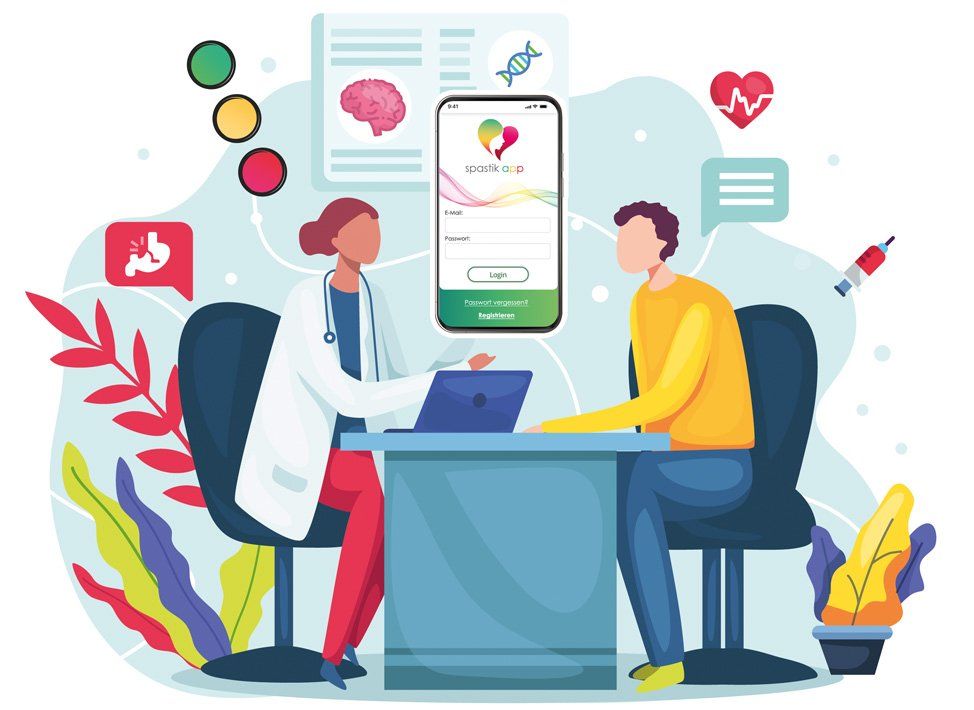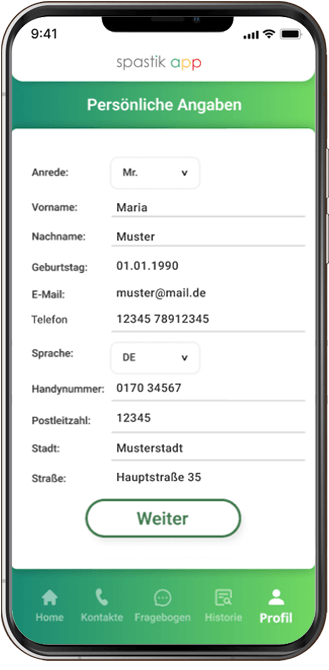The Spasticity App
What makes the spasticity app special?
The reality of care for patients with spastic movement disorders after a stroke is very important. Guideline-compliant treatment of patients with spasticity should follow an interdisciplinary treatment approach. In addition to quickly directing patients to treatment at the correct level of care by physiotherapists, general practitioners and neurologists, the patient should be encouraged to self-manage their symptoms. Using the spasticity app helps patients to pay attention to signs of developing spasticity after a stroke as part of regular self-monitoring and to arrange for early assessment by a doctor.
How does the spasticity app work?
This app is based on the principle of a questionnaire based on the traffic light principle. The user answers a few simple questions at regular intervals (preferably weekly). The spasticity app uses these questions to determine whether there has been a change in health and whether spasticity could develop.
Depending on the test result, the patient is advised to contact his or her family doctor, neurologist or physiotherapist.
This app supports patients after a stroke and helps them to look out for early signs of possible developing spasticity.
This spasticity app can help identify the warning signs of developing spasticity.
This spasticity app is particularly easy to use
handling
The spasticity app works with the help of a digital questionnaire.
Fill in the questionnaire
This should be filled out weekly. Clear videos with explanations will help you give the right answers.
Spasticity-History
The results are saved so that you can track changes in your health status and take timely action.
Data security
As a long-standing expert in the field of eHealth, we have the necessary know-how to protect your data. Data security is very important to us.
It's that easy

Hardware: To use the Spasticity app, you need a smartphone or tablet with an Android or iOS system. The Spasticity app is available in the App Store or Google Playstore and can be downloaded free of charge.
Sequence
1. Open the Spasticity app
If you do not have a user account yet, you can create one here for free.


2. Registration as a patient
Patient admission:
Please enter some information about yourself, the contact details of your doctor and, if applicable, physiotherapist, as well as information about the stroke.
3. The home screen - Home
Previous test result
Start new test
Telephone contact: family doctor, neurologist or physiotherapist


4. Questionnaire
Example question 1 with an explanatory video.
The questionnaire contains 10 questions that are to be answered weekly according to the traffic light principle. There are three answers to each question. Depending on the test result according to the traffic light principle, the patient receives the following information: See Figure 5. Result.
5. Result
Example test result with the recommendation:
"Please contact your family doctor or physiotherapist."
You can contact your family doctor or physiotherapist directly by phone using the spasticity app.
If your doctor or physiotherapist is a customer of Doccura - your online video consultation, you can request a link for an online video consultation from the doctor or physiotherapist via the Spasticity app.

Explanations of the app's videos
Explanation of Video 1:
The relative kneels in front of the patient and moves the foot as shown in the video. He grasps the muscles on the back of the lower leg so that he and the patient can detect the rhythmic muscle contractions - these are also known as clones.
Further explanations:
Exhaustive means that after the cloni are triggered by moving the foot, as shown in the video, the "muscle twitches" that the family member and the patient can feel in the calf muscle on the back of the lower leg, end on their own as soon as the foot is no longer moved.
Inexhaustible means that after the cloni are triggered by moving the foot, as shown in the video, the "muscle twitches" that the family member and the patient can feel in the calf muscle on the back of the lower leg do not stop on their own. The "muscle twitches" can only be stopped by holding the foot.
Explanation for Video 2:
In this video you can see an example of increased physical exertion: putting on a stocking using the right hand. Increased physical exertion can of course also be caused by other physical movements, such as lifting a heavy object, squatting or climbing stairs quickly.
Explanation of Video 3:
Patient gets up from the chair. Subsequent assessment of the knee and foot position. If the leg cannot be stretched and straightened, please press the yellow button. If the heel of the leg that is not fully or completely stretched does not touch the floor, please press the red button.
Explanation for Video 4:
The relative kneels in front of the patient, grasps the affected leg with one hand below the knee and with the other hand grasps the foot. Flexion and extension as shown in the video. The patient and the relative feel either no resistance, slight resistance or pronounced resistance.
Green: Normal movement without resistance. When bending and straightening the knee, neither the patient nor the relative feels any muscular resistance.
Yellow: slight resistance felt by the patient and relatives, as shown in the video.
Red: more difficult resistance or the lower leg can hardly be bent or stretched, in any case only with significantly greater exertion of force compared to the exertion of force shown in the video.
Explanation Video 5:
When walking, the foot turns inwards. The weight is placed on the outside edge of the foot. A slight inward turn means an angle of up to about 45 degrees. Anything beyond that is a strong inward turn and requires the red button to be pressed.
Explanation Video 6:
When sitting, the toes are relaxed and in a normal position. If you stand up and the toes remain in this position, press the green button. Otherwise, assess the toe clawing as described in the buttons.
Explanation Video 7:
The relative fixes the arm in the shoulder area and grabs the wrist and bends and stretches the elbow as shown in the video. First, perform these movements slowly and carefully to get a feel for the movement sequence. Then bend and stretch the elbow joint quickly and ask the patient to give you feedback on whether they feel any discomfort or pain.
Explanation Video 8:
The relative stabilizes the elbow by grasping the patient's elbow from below. The patient performs the movement as shown in the video and assesses the release of the ball as described in the three buttons.
Explanation Video 9:
This video is self-explanatory. To give you an idea: we would define an elbow bend of less than 45 degrees as slight bending and significantly more as severe bending.
Explanation Video 10:
This is easy to do. Sit on a chair and place your forearm on the table in a relaxed position. In this position, the chest muscle is not tense in a healthy person. You can easily push it back and forth or press it in. If necessary, test this on a relative. If the chest muscle is tense in comparison to your tactile experience in yourself or a relative and can hardly be moved or pressed in, then use the yellow button. Any tension beyond this, if it feels like a tense biceps muscle on the upper arm, for example, requires the use of the red button.
What should you do if one of the 10 videos doesn't apply to you?
Please answer the question using the green button below the video.
What are the benefits of using the Spasticity App?This Spasticity App can help you identify the warning signs of developing spasticity.
How does the registration process work?
Your doctor, nursing staff, physiotherapist or relatives will support you in registering and explain in detail the need to use the spasticity app.
How do you use the Spasticity App?
1. In the hospital:
If necessary, the spasticity app will be recommended to you by your doctor, nursing staff, physiotherapist or relatives.

2. Spastic-App Download
A stable internet connection and a smartphone or tablet with an Android or iOS system are required. The download is free from the Google Play Store or App Store.
3. Patient registration
Enter your personal contact details into the Spasticity app.
4. Account activation
Registration
Use of the one-time password that is sent by email
Activation of the account
5. Information about the stroke
The medical data is entered with the help of your doctor, nursing staff, physiotherapists or relatives.
6. Use the spasticity app
Use at home or on the go

Use the Spasticity App questionnaire once a week to obtain a test result based on the traffic light principle.
The result of the questionnaire can yield the following answers according to the traffic light principle (see below).
You have it in your hand
Participation in the Spasticity App is voluntary and you can terminate it at any time.
Our innovation:
Improving care management and quality of care for patients after a stroke.
Developed and recommended by doctors and physiotherapists.














